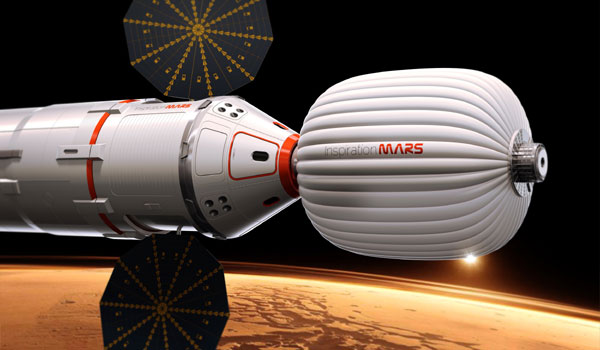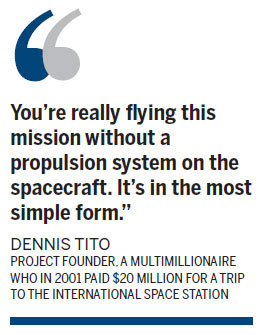
 |
|
The capsule that will carry two people to Mars and back is shown in this artist's rendition released on Wednesday. A nonprofit foundation plans to send two people - possibly a married couple - on a 501-day journey to Mars that would begin in 2018. [Photo/Agencies] |
Call goes out for man and woman, preferably married, to circle red planet.
A nonprofit foundation wants to recruit a man and a woman - possibly a married couple - for a bare-bones, 501-day journey to Mars and back that would start in less than five years, project organizers said on Wednesday.
The mission, expected to cost upwards of $1 billion, would be privately financed by donations and sponsorships.
Project founder Dennis Tito, a multimillionaire who in 2001 paid $20 million for a trip to the International Space Station, said he would pay startup costs for two years to begin development of life-support systems and other critical technologies.

Currently, there are no US spaceships to carry humans in operation, but several are under development and expected to be flying by 2017.
That leaves little time to take advantage of a rare planetary alignment that would allow a craft to loop around Mars, coming as close as about 241 kilometers to the planet's surface, before returning to Earth.
The launch window for the mission opens on Jan 5, 2018. The next opportunity is not until 2031.
"If we don't make 2018, we're going to have some competition in 2031," Tito said.
"By that time, there will be many others that will be reaching for this low-hanging fruit, and it really is low-hanging fruit," said Tito, who set up the nonprofit Inspiration Mars Foundation to organize the mission.
Project chief technical officer Taber MacCallum said US industry is up for the challenge.
"That's the kind of bold thing we used to be able to do," said MacCallum, who also oversees the privately owned Paragon Space Development Corp.
"We've shirked away from risk. I think just seriously contemplating this mission recalibrates what we believe is a risk worth taking for America," he said.
The spacecraft will be bare-bones, with about 17 cubic meters of living space available for a two-person crew. Mission planners would like to fly a man and a woman, preferably a married couple, who would be compatible during a long period of isolation.
The capsule would be outfitted with a life-support system similar to the one NASA uses on the space station, which recycles air, water, urine and perspiration.
"This is going to be a very austere mission. You don't necessarily have to follow all of NASA's guidelines for air quality and water quality. This is going to be a Lewis and Clark trip to Mars," MacCallum said, referring to the explorers who set out across the uncharted American Northwest in 1803.
If the launch occurs in 2018, the capsule would reach Mars 228 days later, loop around its far side and slingshot back toward Earth.
The return trip takes 273 days and ends with an unprecedented 51,119-km/h slam into Earth's atmosphere.
Once the spaceship is on its way, there is no turning back.
"If something goes wrong, they're not coming back," MacCallum said.
The crew would spend much of their time maintaining their habitat, conducting science experiments and keeping in touch with people on Earth.
Tito said he expects the cost to be similar to a robotic mission to Mars. NASA's ongoing Curiosity rover mission cost $2.5 billion. A follow-on mission scheduled to launch in 2020 is expected to run $1.5 billion.
"You're really flying this mission without a propulsion system on the spacecraft. It's in the most simple form," Tito said.
NASA is working on its own heavy-lift rocket and Orion space capsule that could carry crews of four to an asteroid and eventually to Mars.
"We can just barely, every 15 years, fly by Mars with the systems we have right now," MacCallum said. "We're trying to be a stepping-stone."
